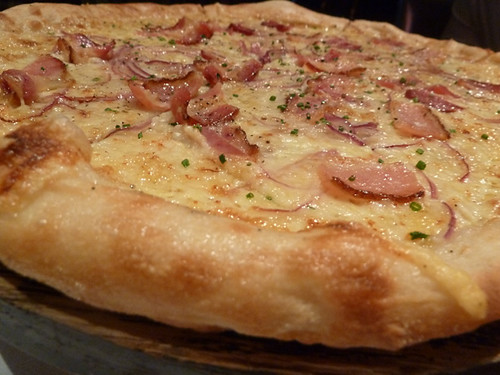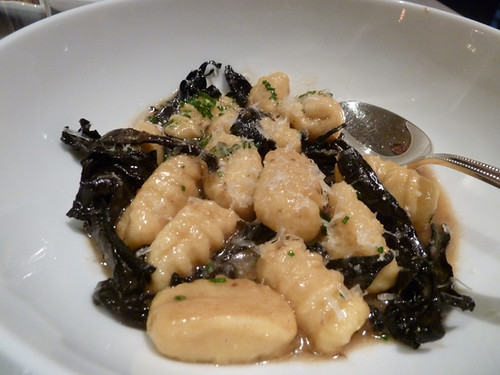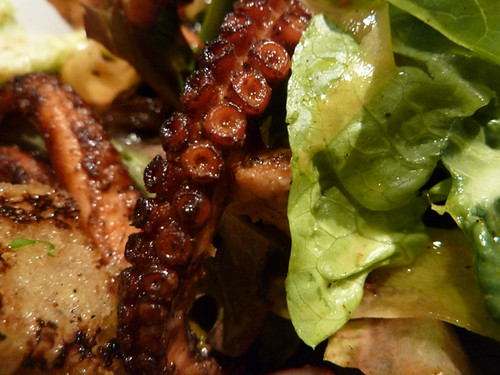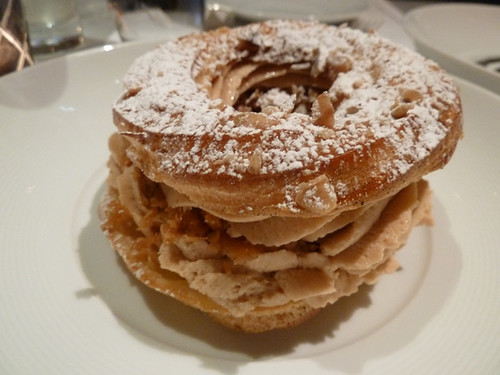Is there a Chicago school of haute cuisine? You could make a case for at least two— the Alinea molecular gastronomy one, and (moving down from the hautest hautes) the porky-whole animal one. Neither originated here (the first descends from El Bulli and French Laundry, the second from Fergus Henderson et al.) but they’ve both been taken to here with enough enthusiasm to seem ours.
So for someone like me, who’s been chasing the latter quite enthusiastically for a couple of years now, and come to half-identify it as what fine dining is in 2011, it’s a bit of a shock whenever you find yourself back in the real haute cuisine, the one truly global one— the food of Finedininglandia, taught in the same schools and served to the same international travelers regardless of whether the hotel you’re in happens to be in Orlando or Singapore. Where both of the other styles radiate personal expression and philosophy from the menu, doing for food the Romantic things that Berlioz did for orchestra conducting, Finedininglandia seems to float above any considerations of place or nationality. Its stock in trade, like that of the fast food franchise on the cross-country highway, has been assurance that what you expect to get is exactly what you will get, no matter where you are in the world.
As you may recall, I shot a Key Ingredient video at the Elysian Hotel in between two fairly momentous moments in the history of its two restaurants, Ria and Balsan, which share a kitchen and head chef. The first one was that Ria had been awarded two Michelin stars, putting it in the top ranks of Chicago restaurants. The second was that, just a few weeks later, chef Jason McLeod “left.” The initial rumor about that was that the Elysian was in trouble and had to cut costs in many areas; the second was that sous chef Danny Grant had been the real star all along (if the hotel was spreading that one to combat the first, it was rather graceless of them). I know exactly what you do about what really happened, which is… nothing.
What was more interesting to me as a question was, was Ria really one of the five best restaurants in Chicago as Michelin would have it? Had it transcended the hotel genre as spectacularly as one of the only other ones at that level, Avenues, with its Alinea-like tasting menus? Or were two Michelin stars in fact the ultimate validation of it as the technically excellent, identity-free restaurant for the traveler who doesn’t want to feel like he’s somewhere?
I couldn’t help suspect, looking at the clubby, sedate dining room in Ria, that it was exactly the sort of internationally anonymous temple of stuffy dining that Michelin would love— and would politely bore me over a very expensive evening. Much more appealing was Balsan, the peppier and more stylish lounge— and part of Ria’s problem drawing crowds may have been that people had discovered that because the same top-drawer kitchen was cooking for both, Balsan was a great value— Ria’s two Michelin stars at a discount.
So I gave Balsan a try with my 12-year-old, who was very excited to get to go out for something so grownup. And you know what? It’s a great restaurant for a hotel. Despite being shoehorned into a weird space with quirks like bathrooms being an elevator ride away— par for the course for hotel dining— it’s a chic, intimately comfortable little room full of energy (even when it’s not full of people). And the food, as much as the menu seemed driven by Finedininglandia’s something-for-everyone ethos (there’s housemade charcuterie and a wood-burning oven for pizzas and a raw bar and small plates and entrees and a hamburger if all else fails), was always expert, and once or twice even personable.
My son was out to try things he’d only heard of before, so we started with a torchon of foie gras, served with housemade grainy mustard (which I thought fell a nudge shy of full flavor) and a chunk of local honeycomb. Next we had what, in retrospect, could easily make a meal of budget chic for someone on a date— the tarte flambee from the wood-burning oven. With housemade bacon, a great nutty gruyere from Uplands in Wisconsin (points for buying regional) and the kiss of wood smoke, this was one of the best “pizzas” I’ve had in years, a welcome sight the next day in the fridge:

Two small plate choices— not that small in either case— followed, both more like doubles than home runs, and just enough shy of perfection to make one wonder if the kitchen was too big for one chef to oversee at a truly exceptional, multiple-Michelin-star level. Gnocchi with Asian mushrooms was the better one, but the gnocchi, aiming for soft and velvety, came perilously close to mushy:

I loved the octopus in an octopus salad— almost as much as I loved the fact that my son wanted to try octopus— and it was prepared beautifully, with a hint of char, but the salad around it was a bit overdressed with its tart dressing. I was happier eating the octopus out of it, and not letting the salad sting my tongue.

We finished with the hanger steak off the large plates, a somewhat hidebound old classic but beautifully done, mineral-tangy beef with a nice char, parsley butter and a heaping pile of fresh-cut fries (slightly dried out, it seemed, to the texture of steak fries; not sure if that was just life under a heat lamp or a deliberate effect to distinguish their fries from a hot dog joint’s).
So a very creditable meal, certainly, if one whose personality had only poked through once or twice. Would I rank it in the top 5 restaurant experiences to be had in town? No, because I’m looking for personality and daring and this meal had only flirted with such things. Grant’s background includes a stint at North Pond, and he professes (see this interview) a farm-to-table philosophy which I can believe based on certain things (such as the hanger steak), but which I nevertheless came to feel is somewhat hidden from the average patron.
But would I recommend it for someone looking for a swank night out? Without hesitation; its best was very good indeed, its low points were only the most modest of dips, its atmosphere felt very big city, its bill didn’t leave me feeling like I’d paid the Hotel Dining Sucker Tax. And then…
I knew nothing— still don’t— about the pastry chef at Ria/Balsan. (No, wait, I know her name, Stephanie; Jason McLeod said it toward the end of the Key Ingredient video.) But Stephanie, whoever you are, you’re like animal acts in vaudeville— no act is good enough to be on the same bill with you and not be at least a little bit overshadowed. We had two of Stephanie’s desserts and they were both eyes-wide-open, oh-my-god good. One was that wonder-turned-cliché of 20 years ago, the molten-center chocolate cake. I would have called it a sign of desperation on the menu if I hadn’t tasted it, because what made this one was the ice cream that went with it, a little football of milk stout ice cream. The beer funk balanced the dark chocolate beautifully, jolting new life into 1992’s favorite dessert.
The other was what’s apparently their signature, the Paris Brest. I have no idea what the name means (wouldn’t that be a train, Paris to Brest on the coast of Brittany?) but the dessert is an eclair shaped sort of like a bagel and filled with a toffee-ish cream with little crunchy bits of something. And it’s wonderful, just wonderful, like biting into a toffee cloud.
Okay, I just Googled it and it’s a fin-de-siecle dessert whose wheel-like shape commemorated a Paris-Brest bicycle race. A praline-flavored bicycle tire. God, no wonder Michelin loved this kitchen’s food.



 If you like this post and would like to receive updates from this blog, please subscribe our feed.
If you like this post and would like to receive updates from this blog, please subscribe our feed.




